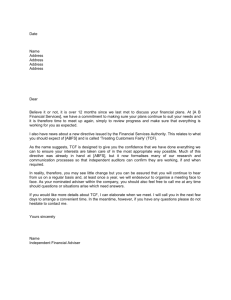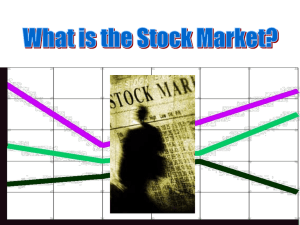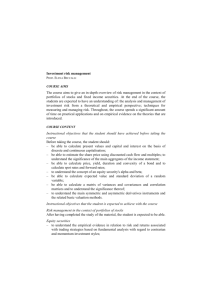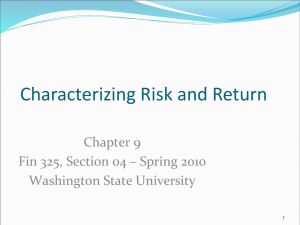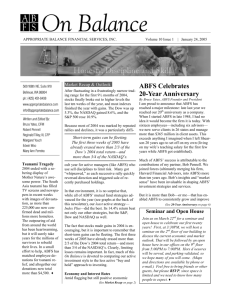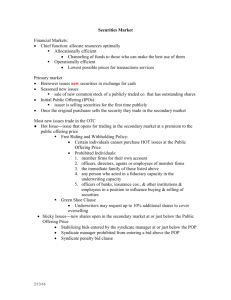Decade of Diminished Returns Continues for Stock Investors
advertisement
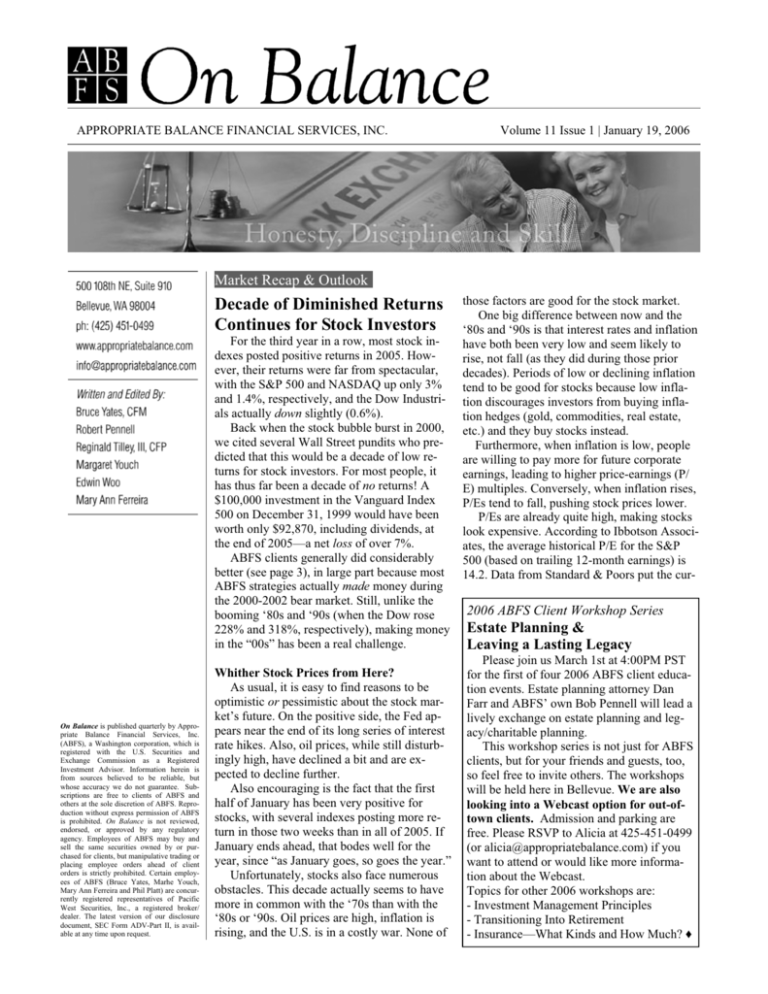
APPROPRIATE BALANCE FINANCIAL SERVICES, INC. Volume 11 Issue 1 | January 19, 2006 Market Recap & Outlook Decade of Diminished Returns Continues for Stock Investors For the third year in a row, most stock indexes posted positive returns in 2005. However, their returns were far from spectacular, with the S&P 500 and NASDAQ up only 3% and 1.4%, respectively, and the Dow Industrials actually down slightly (0.6%). Back when the stock bubble burst in 2000, we cited several Wall Street pundits who predicted that this would be a decade of low returns for stock investors. For most people, it has thus far been a decade of no returns! A $100,000 investment in the Vanguard Index 500 on December 31, 1999 would have been worth only $92,870, including dividends, at the end of 2005—a net loss of over 7%. ABFS clients generally did considerably better (see page 3), in large part because most ABFS strategies actually made money during the 2000-2002 bear market. Still, unlike the booming ‘80s and ‘90s (when the Dow rose 228% and 318%, respectively), making money in the “00s” has been a real challenge. On Balance is published quarterly by Appropriate Balance Financial Services, Inc. (ABFS), a Washington corporation, which is registered with the U.S. Securities and Exchange Commission as a Registered Investment Advisor. Information herein is from sources believed to be reliable, but whose accuracy we do not guarantee. Subscriptions are free to clients of ABFS and others at the sole discretion of ABFS. Reproduction without express permission of ABFS is prohibited. On Balance is not reviewed, endorsed, or approved by any regulatory agency. Employees of ABFS may buy and sell the same securities owned by or purchased for clients, but manipulative trading or placing employee orders ahead of client orders is strictly prohibited. Certain employees of ABFS (Bruce Yates, Marhe Youch, Mary Ann Ferreira and Phil Platt) are concurrently registered representatives of Pacific West Securities, Inc., a registered broker/ dealer. The latest version of our disclosure document, SEC Form ADV-Part II, is available at any time upon request. Whither Stock Prices from Here? As usual, it is easy to find reasons to be optimistic or pessimistic about the stock market’s future. On the positive side, the Fed appears near the end of its long series of interest rate hikes. Also, oil prices, while still disturbingly high, have declined a bit and are expected to decline further. Also encouraging is the fact that the first half of January has been very positive for stocks, with several indexes posting more return in those two weeks than in all of 2005. If January ends ahead, that bodes well for the year, since “as January goes, so goes the year.” Unfortunately, stocks also face numerous obstacles. This decade actually seems to have more in common with the ‘70s than with the ‘80s or ‘90s. Oil prices are high, inflation is rising, and the U.S. is in a costly war. None of those factors are good for the stock market. One big difference between now and the ‘80s and ‘90s is that interest rates and inflation have both been very low and seem likely to rise, not fall (as they did during those prior decades). Periods of low or declining inflation tend to be good for stocks because low inflation discourages investors from buying inflation hedges (gold, commodities, real estate, etc.) and they buy stocks instead. Furthermore, when inflation is low, people are willing to pay more for future corporate earnings, leading to higher price-earnings (P/ E) multiples. Conversely, when inflation rises, P/Es tend to fall, pushing stock prices lower. P/Es are already quite high, making stocks look expensive. According to Ibbotson Associates, the average historical P/E for the S&P 500 (based on trailing 12-month earnings) is 14.2. Data from Standard & Poors put the cur- 2006 ABFS Client Workshop Series Estate Planning & Leaving a Lasting Legacy Please join us March 1st at 4:00PM PST for the first of four 2006 ABFS client education events. Estate planning attorney Dan Farr and ABFS’ own Bob Pennell will lead a lively exchange on estate planning and legacy/charitable planning. This workshop series is not just for ABFS clients, but for your friends and guests, too, so feel free to invite others. The workshops will be held here in Bellevue. We are also looking into a Webcast option for out-oftown clients. Admission and parking are free. Please RSVP to Alicia at 425-451-0499 (or alicia@appropriatebalance.com) if you want to attend or would like more information about the Webcast. Topics for other 2006 workshops are: - Investment Management Principles - Transitioning Into Retirement - Insurance—What Kinds and How Much? Ƈ rent P/E between 17 and 20. Major bull markets typically start with P/Es significantly below average, not above (as they are now). Looking just at 2006, we must also consider the fact that, over the past 50 years, there have only been seven times when the S&P 500 posted gains three years in a row (as it just has). On only two of those seven occasions did it continue rising more than three consecutive years—once during the late ‘90s bubble, and once in the huge bull market that began in 1982. Both of those periods included unusually bullish economic backdrops that are vastly different from current conditions. The “Market” vs. Your Account Despite the possibility of continued low returns for stocks in general, we are actually quite optimistic about the outlook for ABFS growth strategies. In 2005, all four of our primary growth strategies outperformed both the Dow and NASDAQ, and two of the four also posted better total returns than the S&P 500 (see page 3). As in the previous two years, our least-actively managed strategy, Index Plus (not timed) performed best. That reflects the choppy market conditions that generally prove more difficult for more active strategies. Exciting Developments at ABFS As subdued as 2005 returns were, we at ABFS weren’t just sitting on our hands waiting for things to improve. We are always striving to refine and improve our internal systems, techniques and decision-making processes. We recognize times in the past few years when our strategies could have done better. We believe it is important to analyze missed opportunities and adapt our disciplines so that we are better prepared the next time similar opportunities arise. To that end, ABFS growth managers Bob Pennell and Eddie Woo spent considerable time in 2005 actively fine tuning some of our investment models. In fact, they spent several hundred hours on one specific project to try to increase your returns during choppy market environments like the ones we experienced in 2004 and 2005. Working closely with an outside expert, Bob and Eddie have now developed something called the “ABFS Composite.” This custom indicator assesses—on a daily basis—a variety of other market indicators and quickly provides a better sense of underlying market risk, momentum and stamina. One important aspect of the ABFS Composite is that, in addition to helping monitor the broad market, it can be applied to individual industry sectors. It enables us to—in a matter of minutes—look at price, breadth and volume data for thousands of individual stocks within given sectors (or more specifically, exchange traded sector funds). This powerful new tool enables us to quickly screen massive quantities of data for useful insights that can help determine what (and when) to buy and sell. Such massive, customized number-crunching wasn’t even possible a few years ago, but now we are harnessing it to make better decisions. We’ve done considerable modeling and “back-testing” with the new ABFS Composite, and we are extremely encouraged by the results. We believe it will help us improve your returns— especially during choppy markets— while still maintaining the limits on downside risk that are so important to long-term performance. But the proof will be in the pudding, i.e., when we start integrating and using the ABFS Composite in the months ahead. As sophisticated as the ABFS Composite may be, it is important to remember that there is still no Holy Grail in investing—a foolproof way of always beating the market. Ultimately, good investing requires a combination of art and science, i.e., sound judgment and considerable experience as well as good technical tools. Indexing Lags Again For the seventh consecutive year, the average actively managed stock fund outperformed the S&P 500 index in 2005. This reinforces our belief that index funds, which were all the rage in the late ‘90s, have real drawbacks. One reason so many funds can beat indexes like the S&P 500 is that actively managed funds typically contain many stocks of small and midsize companies. These smaller stocks have done considerably better than large company stocks that are heavily weighted in most indexes. This “capitalization weighting” means that the largest stocks have dramatically more impact on index performance 2 than smaller ones, so returns tend to depend on relatively few (the largest) stocks in the index. During the speculative bubble of the late ‘90s, this “cap-weighting” worked in the indexes’ favor because big tech stocks were hot. But since then, those big stocks have struggled. Does this mean you can consistently beat the S&P 500 simply by buying a “better than average” fund or group of funds? Unfortunately, it’s not that simple. As Burton Malkiel, a Princeton economics professor and director at Vanguard, points out, “It’s often the case that about half the funds can beat the index in any given year. But it’s not the same half each year.” Sometimes, the “better than average” funds are found in specific areas of the market (such as energy or precious metals). Sometimes they aren’t even U.S. funds, but invest in foreign stocks. What is clear is that, as rapidly as the world changes, today’s top performers may well be tomorrow’s dogs. We have long maintained that simply buying and blindly holding onto any stock or fund is dangerous. The 2000-2002 bear market highlighted that danger, as many investors saw their stock portfolios drop by half or more and still haven’t recovered. Yet most stock investors (and even investment managers) still invest that way; they buy a group of stocks or funds, and then just hang on and “hope for the best.” The goal of ABFS’ growth strategies, on the other hand, is to identify—and buy for you—some of the funds that can beat the indexes over the next few years. But a year or two from now, we expect to identify more funds at that time (likely including some different ones) that can beat the indexes from that point. We don’t pretend to know which funds or sectors will be best five years from now. But we try to maintain a unique mix of funds that reduces portfolio risk (volatility) and also takes advantage of market trends as they appear. We believe that the active, dynamic approach ABFS employs (and constantly strives to refine/ improve) is the best way to protect you from large bear market losses, while still building your capital so you can reach your long-term financial goals. Ƈ PERFORMANCE OF ABFS GROWTH STRATEGIES Inception through December 31, 2005 1 ACTUAL RETURNS (Client Accounts) Cumulative (1/1/99-12/31/05) Value of $100,000 1 ABFS Strategies Momentum Growth 2 Component Returns for Each Year 2 2000 2001 2002 2003 +5.5% +5.5% -1.7% +19.0% _ $217,677 1999 +50.4% Value Plus $208,899 +26.4% +16.8% +9.5% +0.7% +14.0% +7.0% +5.2% Managed Risk $200,048 +22.9% +15.7% +13.8% +3.8% +12.7% +2.7% +2.9% +20.1% +14.4% +8.2% -12.0% -22.2% +28.5% +10.7% -21.1% -31.5% +50.0% +8.6% +4.8% +1.4% Investment Index Plus $144,172 Indexes Vanguard Index 500 NASDAQ $112,352 $100,575 1 1 1 n/a -5.4% +21.1% +85.6% -9.1% -39.3% +6.9% -4.1% 2004 +7.3% 2005 +3.6% SUPPLEMENTAL “MODEL PORTFOLIO” INFORMATION 3 RISK/VOLATILITY3 SD MDD Momentum Gr. Value Plus Managed Risk Index Plus Vanguard Index 500 NASDAQ 2.5% 2.1% 1.5% 3.1% 5.4% 9.2% -12.2% -9.1% -6.2% -12.4% -47.5% -77.9% FOOTNOTES 1 2 3 The first three ABFS strategies have existed under their current approach and trading disciplines since the beginning of 1999 (the entire graph period). The Index Plus strategy began in early 2000, so its data begin 3/31/00. Yearly “component” return figures are actual net returns to clients after all fees and expenses. “Cumulative Value of $100,000 Investment” includes the returns in all individual “component” periods (same as graph period, except for Index Plus, which only has data from 3/31/00 on), compounded at the end of each year or partial year shown under “component” periods. The supplemental Model Portfolio information (graph and risk/volatility data) attempts to reflect the same mix and proportions of mutual funds purchased for clients, adjusted daily for purchases and sales made in actual client accounts. While these data, created using FastTrack computer software, roughly reflect fluctuations in actual client accounts, they are not drawn from actual account values, and therefore do not represent actual trading (whereas the “Actual Returns” in the table above do). See additional limitations and disclosures regarding Model Portfolio data on page 4. All data on this sheet for the NASDAQ and Vanguard Index 500 (a mutual fund based on the S&P 500 index) are actual data. Risk/Volatility Measures (larger numbers = higher volatility/risk) for the entire graph period: SD = monthly standard deviation of return. MDD = maximum draw-down in account value from any high point to subsequent low point during the graph period. This is the worst decline in value “endured” in order to achieve each investment’s return. IMPORTANT: The above is not complete without notes and disclosures on page 4 3 Notes Regarding ABFS Growth Strategy Performance (on page 3) GENERAL The data and graph on page 3 are for informational purposes only. Proper interpretation requires some knowledge of market risks, returns and portfolio theory. This information is best used by professionals, and the general public should not act based on it without substantial explanation, qualification, and discussion. We believe – but do not guarantee – that these data are accurate. Of course, there is no assurance that future returns, declines, or volatility will in any way resemble the past, or that results will even be profitable. We do not intend to imply that high relative returns will be produced on an ongoing basis, and periods of negative returns should be expected. Investors should be prepared to endure such periods, and should be sure money invested in growth portfolios is of a long-term nature (not needed for at least 5-10 years). The first three ABFS growth strategies shown (Momentum Growth, Value Plus and Managed Risk—or their predecessors, which were also created and managed by Robert Pennell, the current primary growth manager) have existed since late 1986. However, their methodology has evolved and changed significantly over the years, and a major modification occurred in late 1998. This modification included the implementation of much stricter sell disciplines intended to help optimize risk-adjusted returns and reduce absolute downside exposure. Because of the significance of the change in late 1998, we believe only the performance since then is representative of these strategies’ current management style, and hence only that period is shown. The fourth ABFS strategy shown—the Index Plus (NonTimed) mutual fund strategy—has only existed since early 2000; its first full year of client data is 2001. Due to these limited track records, investment decisions should not be based solely on these results. Investors should make sure they fully understand and agree with each management style utilized. Due to our emphasis on stop-loss disciplines, much of the return in the ABFS growth strategies is expected to be in the form of short-term capital gains, making these strategies most attractive for tax-sheltered accounts and/or clients wishing to reduce exposure to large declines, rather than for taxable investors who are concerned with minimizing taxes. RETURNS Returns for ABFS strategies are “iterative internal rate of return” figures for actual client portfolios. The figures for each component period include all client accounts (even new and terminated ones) that were invested in that strategy for the entirety of that calendar year (partial year for the latest component period when less than a full year), but exclude any non-managed securities (which were occasionally held at clients’ request) in those accounts. We have used the returns for all clients invested in a each strategy for each full year, rather than only results for clients invested since the beginning, because ABFS has had more clients in each strategy each year. Thus, we believe that calculating the returns including all clients invested for each full year (rather than only those in the strategy “from the beginning”) provides a much larger sample of returns, and is therefore more representative of the returns generally achieved for clients each year. Cumulative “Value of $100,000 Investment” is calculated by simply compounding actual returns for the component periods at the end of each year. Note that for Index Plus, all data are for a shorter period than for the other three strategies, due to its later introduction. Returns are calculated on a dollar-weighted basis; that is, they include the actual beginning values, all expenses (including management fees and transaction costs), and deposits and withdrawals for all accounts, calculated as one large “portfolio” for each strategy. Returns are therefore net of all fees and transaction charges, and include reinvestment of all dividends and earnings. Returns ignore tax implications, which may be a significant consideration for taxable accounts. Actual individual client returns usually differ somewhat, depending on such factors as each client’s beginning date, transaction costs (which vary by account size), additions and withdrawals during the period, etc. Data for the “Vanguard Index 500” Fund (VFINX), an “index” fund based on the S&P 500 index, is for VFINX’s total return, including all dividends. “NASDAQ” data are for the NASDAQ Composite index price only. MODEL PORTFOLIO DATA Graph As stated above, the return figures in the data table represent trading in actual client accounts. The colored mountain-type graph and the risk/volatility data, on the other hand, are based on a model portfolio with approximately the same mix and proportions of mutual funds held for clients, adjusted daily for purchases and sales made in actual client accounts. Model portfolio data take into account a model portfolio fee, but because they are not drawn from actual account values, they do not represent actual trading in client accounts (as the “Actual Return” figures in the table do). Model trading is subject to various limitations. It does not involve financial risk and cannot completely account for the impact of financial risk involved with actual trading. Model trading or model performance may not reflect the impact that material economic and market factors might have had on the management of actual client accounts. The performance results of a model portfolio do not reflect actual investors’ ability to withstand losses or to adhere to a particular trading strategy in spite of trading losses, which can adversely affect actual trading performance (results). Therefore, while we believe the graph and risk/volatility measures provide a rough approximation of ABFS strategy fluctuations, they are not meant to precisely represent the fluctuations in every ABFS account or take the place of the actual account returns reflected in the table above the graph. Note that the Managed Risk strategy contains individual income-oriented securities as well as funds. Since the graph reflects only mutual funds, a short-term bond fund was used to represent those other securities. This substitution is not to imply that such securities and short-term bond funds are equivalent (the individual securities are in fact often riskier), but rather to somehow attempt to account for them in the graph. Note that the “Actual Return” figures in the table above the graph do reflect Managed Risk clients’ actual holdings (including all individual securities), so they do incorporate the actual impact of those securities on returns. Risk/Volatility Measures Generally, investment analysts measure portfolio risk using some type of volatility measure that includes both realized and unrealized (paper) gains and losses. Two such volatility figures are shown for the model portfolio in the accompanying table: SD = monthly standard deviation of return for the period. SD reflects the range of variation in return, both up and down. MDD = maximum draw-down (decline) in account value from any high point to subsequent low point during the period. Unlike SD, MDD focuses only on downside fluctuation (which some people consider more useful as a measure of risk than fluctuation up and down). In essence, MDD shows the worst decline in value “endured” during the period in order to achieve the resulting return. Although SD and MDD figures relate to each strategy’s volatility and declines during the periods shown, they cannot indicate all types or amounts of risk taken in each strategy, and how those risks differ from the S&P 500 or NASDAQ indexes. For example, the S&P 500 is an index of U.S. large company stocks. ABFS growth strategies, while primarily utilizing mutual funds containing stocks, often employ funds containing types of securities different than the S&P 500, such as small company stocks, foreign stocks, domestic or foreign bonds, convertible securities, and/or cash equivalents. The Managed Risk strategy may also contain individual income-oriented securities in addition to mutual funds. We believe the flexibility to use a wide variety of securities and market sectors facilitates enhanced risk-adjusted performance, but investors should be aware that individual holdings purchased in these strategies may have substantially different (and greater) risks than the S&P 500 and/or NASDAQ, and that direct comparison with these or any other indexes is not possible. The comparisons to these indexes in the table and graph are only meant to provide a general idea of relative return and volatility, and should not be taken to imply that ABFS strategies are actually similar to VFINX, the S&P 500, the NASDAQ, or any other index or investment. ABFSDGPDisc010906 4
